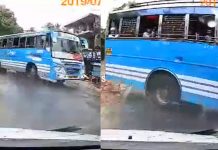A tractor is an engineering vehicle specifically designed to deliver a high tractive effort (or torque) at slow speeds, for the purposes of hauling a trailer or machinery used in agriculture or construction.
Most commonly, the term is used to describe a farm vehicle that provides the power and traction to mechanize agricultural tasks, especially (and originally) tillage, but nowadays a great variety of tasks. Agricultural implements may be towed behind or mounted on the tractor, and the tractor may also provide a source of power if the implement is mechanised.
The first powered farm implements in the early 19th century were portable engines – steam engines on wheels that could be used to drive mechanical farm machinery by way of a flexible belt. Richard Trevithick designed the first ‘semi-portable’ stationary steam engine for agricultural use, known as a “barn engine” in 1812, and it was used to drive a corn threshing machine.
The Power of Tractor : Amazing Off-Road VIDEO
The truly portable engine was invented in 1839 by William Tuxford of Boston, Lincolnshire who started manufacture of an engine built around a locomotive-style boiler with horizontal smoke tubes. A large flywheel was mounted on the crankshaft, and a stout leather belt was used to transfer the drive to the equipment being driven. In the 1850s, John Fowler used a Clayton & Shuttleworth portable engine to drive apparatus in the first public demonstrations of the application of cable haulage to cultivation.
Most older farm tractors use a manual transmission with several gear ratios, typically three to six, sometimes multiplied into two or three ranges. This arrangement provides a set of discrete ratios that, combined with the varying of the throttle, allow final-drive speeds from less than one up to about 25 miles per hour (40 km/h), with the lower speeds used for working the land and the highest speed used on the road.
Slow, controllable speeds are necessary for most of the operations performed with a tractor. They help give the farmer a larger degree of control in certain situations, such as field work. However, when travelling on public roads, the slow operating speeds can cause problems, such as long queues or tailbacks, which can delay or annoy motorists in cars and trucks.
These motorists are responsible for being duly careful around farm tractors and sharing the road with them, but many shirk this responsibility, so various ways to minimize the interaction or minimize the speed differential are employed where feasible. Some countries (for example the Netherlands) employ a road sign on some roads that means “no farm tractors”. Some modern tractors, such as the JCB Fastrac, are now capable of much higher road speeds of around 50 mph (80 km/h).
Older tractors usually have unsynchronized transmission designs, which often require the operator stop the tractor to shift between gears. This mode of use is inherently unsuited to some of the work tractors do, and has been circumvented in various ways over the years.
For existing unsynchronized tractors, the methods of circumvention are double clutching or power-shifting, both of which require the operator to rely on skill to speed-match the gears while shifting, and are undesirable from a risk-mitigation standpoint because of what can go wrong if the operator makes a mistake – transmission damage is possible, and loss of vehicle control can occur if the tractor is towing a heavy load either uphill or downhill – something that tractors often do.
Therefore, operator’s manuals for most of these tractors state one must always stop the tractor before shifting, and they do not even mention the alternatives. As already said, that mode of use is inherently unsuited to some of the work tractors do, so better options were pursued for newer tractor designs.
In these, unsynchronized transmission designs were replaced with synchronization or with continuously variable transmissions (CVTs). Either a synchronized manual transmission with enough available gear ratios (often achieved with dual ranges, high and low) or a CVT allow the engine speed to be matched to the desired final-drive speed, while keeping engine speed within the appropriate speed (as measured in rotations per minute or rpm) range for power generation (the working range) (whereas throttling back to achieve the desired final-drive speed is a trade-off that leaves the working range).
The problems, solutions, and developments described here also describe the history of transmission evolution in semi-trailer trucks. The biggest difference is fleet turnover; whereas most of the old road tractors have long since been scrapped, many of the old farm tractors are still in use. Therefore, old transmission design and operation is primarily just of historical interest in trucking, whereas in farming it still often affects daily life.



















